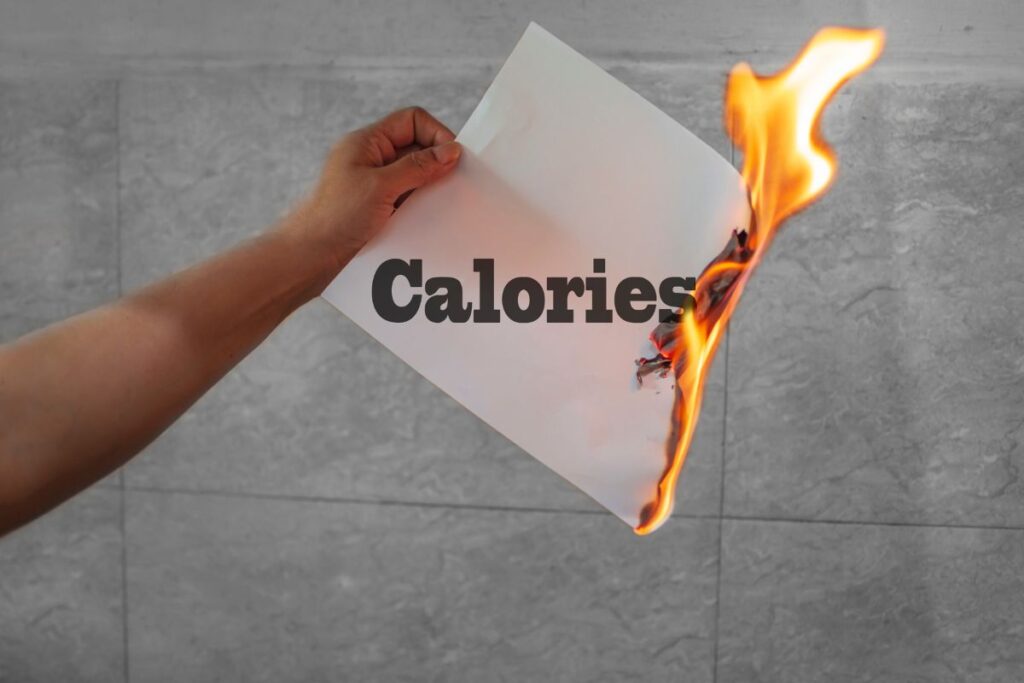There are many different factors to consider when it comes to weight loss. One of the most important is your daily calorie turnover, which is the total number of calories you eat and burn daily.
Calorie turnover is different from calorie deficit. A person with a higher calorie turnover is more active than one with a lower calorie turnover. While both may be in a calorie deficit, the person with the higher calorie turnover is more fit metabolically. Also, they can lose weight faster and maintain a healthier weight longer.
If you burn more calories than you consume, you will lose weight. However, a calorie deficit and weight maintenance is more sustainable when you have a higher daily calorie turnover.
What is Daily Calorie Turnover?
Your daily calorie turnover is made up of two components: total daily energy expenditure and diet calories.
The total daily energy expenditure calories comes from your basal metabolic rate (BMR) and activities. BMR is the number of calories your body burns at rest. It is determined by factors such as your age, sex, height, and weight.
Activity calories refers to the calories you burn from moving. Activities include exercise and non-exercise activity thermogenesis (NEAT). NEAT activities include things such as walking, eating, and fidgeting. One can also say that BMR calories come from the calories burned by internal organs, while activity calories come from the calories burned by muscles.
Thus daily calorie turnover is a total of all calories consumed and burned. In short it is the amount of calories your body processess a day and does not distinguish between if the calories are coming in or going out of the body.

Why is Daily Calorie Turnover Important?
Your daily calorie turnover is vital for weight loss because it determines how healthy your metabolism is and whether you can sustain long-term metabolic fitness.
The goal of weight loss is to maintain a healthy weight in the long term through a healthy lifestyle. Cutting calories to create a calorie deficit is not sustainable in the long term.
Finally, cutting too many calories from your diet will damage your metabolism and cause muscle loss. This will make it harder for you to lose weight in the future. Also, it will make it easier to gain weight and add a few extra pounds.
How to Use Daily Calorie Turnover for Weight Loss
There are a few things you can do to use your daily calorie turnover for weight loss:
- Calculate your daily calorie needs. The first step is to calculate your daily calorie needs. This will tell you how many calories you must consume to maintain weight. You can use a calorie calculator to do this.
- Create a calorie deficit. To lose weight, you need to create a calorie deficit. This means that you need to consume fewer calories than you burn. You can do this by eating less food and exercising more.
- Be patient. Losing weight takes time and effort. Don’t get discouraged if you don’t see results immediately. Just keep at it, and you will eventually reach your goals.
How to Calculate Daily Calorie Turnover for Weight Loss
A 30-year-old man who is 5’10” and weighs 200 pounds with moderate activity and 30 minutes of exercise daily can determine daily calorie turnover with the following steps:
- A BMR of 2,500 calories per day and activity calories of 1000 calories a day equal 3500 total daily energy expenditure calories.
- A 3000 daily diet calories would give you a daily calorie turnover of 6500 calories (3500 + 3000) and a calorie deficit of 500 calories (3500 – 3000).
A high daily calorie turnover in this case would allow you to lose 1 pound per week, maintain muscle and a healthy metabolism. How you lose weight is as important as how much weight you lose.

Here are a few ways to create a calorie deficit of 500 calories per day:
- Eat a smaller breakfast. Instead of eating a big breakfast, try eating a smaller breakfast and a larger lunch or dinner.
- Skip the sugary drinks. Sugary drinks are high in calories and low in nutrients. Instead of drinking soda, juice, or coffee drinks with added sugar, drink water or unsweetened tea.
- Add more vegetables to your meals. Vegetables are low in calories and high in nutrients. Add more vegetables to your meals to help you feel full without consuming too many calories.
- Get more exercise. Exercise is a great way to burn calories and lose weight. Aim for at least 30 minutes of moderate-intensity exercise most days of the week.
Following these tips, you can use your daily calorie turnover for weight loss and reach your goals.
Here are The Keys to Success for using daily calorie turnover for weight loss
- Be patient. Losing weight takes time and effort. Don’t get discouraged if you don’t see results immediately. Just keep at it, and you will eventually reach your goals.
- Make small changes. Don’t try to make too many changes at once. This can be overwhelming and lead to you giving up. Instead, make small changes that you can stick with over time. For example, you could start by cutting sugary drinks or adding a 30-minute walk to your daily routine.
- Find a support system. Having a support system can make a big difference in your weight loss journey. Find friends, family, or a weight loss group that can support you and help you stay motivated.
Following these keys, you can use your daily calorie turnover for weight loss and reach your goals.
Additional Tips on How to Use Daily Calorie Turnover for Weight Loss
Using your daily calorie turnover for weight loss is a simple and effective way to lose weight. Following the tips above, you can create a calorie deficit and lose weight safely and effectively. In addition to the tips above, here are a few additional tips for using daily calorie turnover for weight loss:
- Track your calories. One of the best ways to ensure that you create a calorie deficit is to track your calories. There are many different ways to do this, including using a food diary, a calorie-counting app, or a wearable device.
- Make small changes. Don’t try to make too many changes at once. This can be overwhelming and lead to you giving up. Instead, make small changes that you can stick with over time. For example, you could start by cutting sugary drinks or adding a 30-minute walk to your daily routine.
- Find a support system. A support system can make a big difference in your weight loss journey. Find friends, family, or a weight loss group that can support you and help you stay motivated.
Following these tips, you can use your daily calorie turnover for weight loss and reach your goals. If you are on a weight loss journey, share this article on Facebook or Twitter to help others learn more about losing weight.
Q&A Section for “Daily Calorie Turnover”
Q1: What is daily calorie turnover, and why is it important for weight loss?
Daily calorie turnover refers to the total number of calories you burn daily, including resting metabolic rate (the calories burned to maintain essential bodily functions) and physical activities. Understanding your daily calorie turnover is crucial for weight loss because it helps you determine how many calories you should consume to create a caloric deficit, which is essential for losing weight.
Q2: How can I calculate my daily calorie turnover?
To calculate your daily calorie turnover, start by determining your Basal Metabolic Rate (BMR) using the Harris-Benedict equation, which considers your age, sex, weight, and height. Then, factor in your physical activity level using the Physical Activity Level (PAL) scale. Your daily calorie turnover is the sum of your BMR and the calories expended through physical activities.
Q3: Can daily calorie turnover change over time?
Your daily calorie turnover can change due to aging, weight loss or gain, and physical activity levels. For instance, your BMR typically decreases as you lose weight, which may require you to adjust your calorie intake or increase physical activity to continue losing weight.
Q4: What is a caloric deficit, and how does it relate to weight loss?
A caloric deficit occurs when you consume fewer calories than you burn, forcing your body to use stored fat for energy, leading to weight loss. To create a caloric deficit, either increase your daily physical activity to burn more calories or consume fewer calories, or ideally, do both.
Q5: How can I ensure my calorie counting for weight loss is accurate?
To improve the accuracy of your calorie counting:
- Use a food scale to measure portions.
- Track everything you eat using a food diary or an app.
- Be mindful of hidden calories in beverages, dressings, and sauces.
- Remember to account for all snacks and tasting while cooking.
Q6: Is reducing calorie intake safe for faster weight loss?
Significantly reducing calorie intake can be counterproductive and potentially harmful. Extreme calorie restriction can lead to muscle loss, nutritional deficiencies, and decreased metabolic rate. Aiming for a moderate calorie deficit and focusing on a balanced diet rich in nutrients is recommended.
Q7: How important is exercise in increasing daily calorie turnover for weight loss?
Exercise plays a crucial role in increasing daily calorie turnover. It burns calories and builds muscle, which can increase your BMR. Cardio and strength training is often recommended for optimal weight loss results.
Q8: Can stress and sleep affect my daily calorie turnover?
Yes, both stress and sleep can significantly impact your daily calorie turnover. Poor sleep can lower metabolism and increase hunger hormone levels, leading to higher calorie intake. Stress can also lead to hormonal changes that might affect appetite and fat storage.
Q9: Should I adjust my calorie intake if my weight loss plateaus?
If you experience a weight loss plateau, it may be necessary to reevaluate and adjust your calorie intake. As you lose weight, your body requires fewer calories for maintenance, so recalculating your BMR and daily calorie needs can help you continue progressing.
Q10: How can I maintain weight loss after reaching my goal?
To maintain weight loss:
- Continue monitoring your calorie intake and physical activity.
- Adopt a balanced, sustainable eating pattern.
- Stay active and incorporate regular exercise.
- Regularly reassess your calorie needs as your body and lifestyle change.




